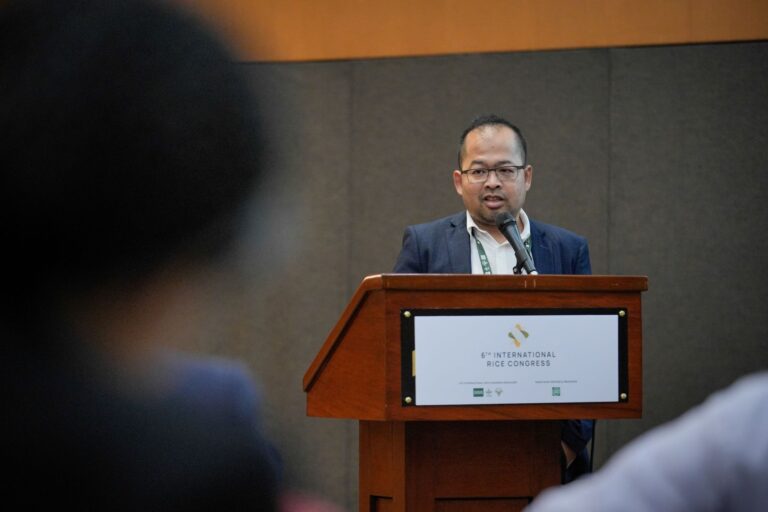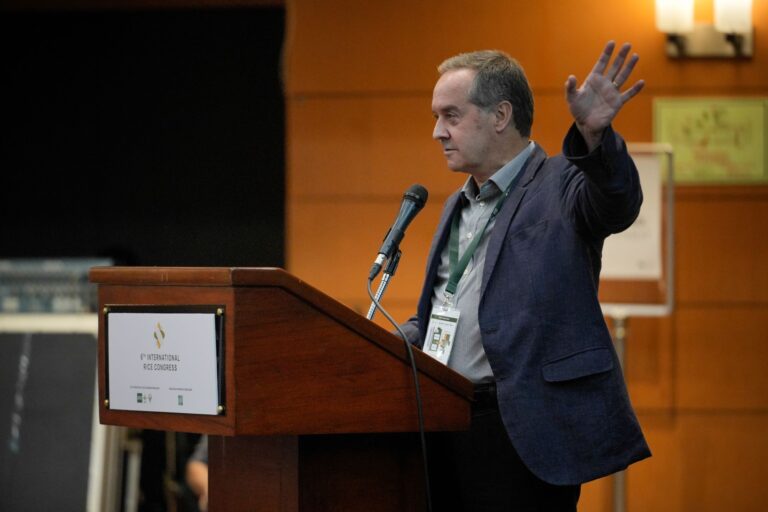Manila, Philippines (23 October 2023) – Forward-thinking policies focusing on the impacts of recent political and environmental shocks and addressing gender and social inclusion vulnerabilities are important in sustaining local and global solutions to food and nutrition security under climate change. This was the theme of the Foresight to Accelerate Food Systems Transformation side event at the recently concluded 6th International Rice Congress.
Foresight analysis is the act of thinking about the future to guide decisions that are being made today. It may involve a wide range of qualitative and quantitative tools and approaches depending on the time horizon and the level of complexity and uncertainty of the particular question of interest.

For example, based on data from the United Nations Food and Agriculture Organization (FAO), rice production is considered more stable than maize and wheat. Further, projecting that climate change would exacerbate its environmental effects on the agricultural industry, “The land allocated for rice will be the same, but there will be a decline in the per capita availability of land,” said Dr. Harold Glenn Valera, an Economic Modeler at the International Rice Research Institute (IRRI) and one of the event presenters.
Aside from the lack of available areas, rice cultivation is the third highest emitter of non-carbon dioxide greenhouse gas (GHG) in the agricultural sector.

Source: What do we know about the future of rice in relation to food system transformation?
Political instability is also a driving force to global inflation, according to Professor Ashok Mishra of the Morrison School of Agribusiness at Arizona State University. For instance, the conflict between Russia and Ukraine triggered global disruptions in markets for key food crops and fertilizers. It caused a historical increase in global fertilizer prices in 2023, which heavily affected global rice production and will continue to do so for the years to come.
Foresight analyses play a crucial role in enlightening policymakers about the potential economic repercussions stemming from both natural and man-made catastrophes on agricultural systems. Furthermore, they serve as a guiding force for policymakers, directing their decisions toward specific objectives with varied impacts. An exemplary illustration of this comes from Dr. Athanasios Petsakos, an economist affiliated with the Alliance Bioversity-CIAT.
Dr. Petsakos explored investment scenarios for rice research and development (R&D) in Latin America. His findings underscored that escalating R&D investments with the goal of achieving higher yields would primarily benefit producers economically, yet have limited impact on consumers and on the overall food security in the region. Emphasizing the need for a more holistic approach when prioritizing R&D investments, Petsakos stressed the importance of identifying broader impacts — determining winners, losers, and the geographical distribution of these effects.

Given the heterogeneous nature of these impacts and the imperative to meet global food demands sustainably, recent foresight research advocates for a heightened focus on developing more nutritious varieties of rice. This approach aligns with the overarching goal of sustainable intensification, acknowledging the diverse challenges and opportunities that lie ahead in ensuring an ample and nutritious food supply for the world.
Policies should also focus on regulating farm size and distribution, Dr. Harold Valera cites Kruseman et.al. There should also be increased institutional incentives or financial aid to farmers to offset price shocks. Highlighting the benefits and strengthening farmer organizations can also help smallholder farmers to have greater access to markets, information, and production facilities.
According to Ms. Chin Yee Chan, a Scientist from WorldFish, aquatic foods are nutrient-rich, generate low emissions and impacts on land and water, and contribute to the human health, well-being, and livelihoods of rural communities. Understanding the future of rice-fish demand and supply to contribute to food and nutrition security is vital in the ASEAN region’s food system, according to Dr. Nhuong Tran, Senior Scientist from WorldFish.

Trade-offs in sustainable intensification are inevitable, according to Dr. Guy Hareau, principal scientist at the International Potato Center (CIP). Although technologies are available, these do not immediately translate to sustainability. A systems approach informed by empirical research and aligned with socio-economic realities is important in figuring out optimized farming strategies.
“The value of foresight analysis is more on the direction it provides than the quantification of things,” said Dr. Samarendu Mohanty, Regional Director for Asia at the International Potato Center (CIP) on the role of foresight analysis in guiding policies for agri-food systems transformation.
“Forward looking analyses shed clarity, bring to the foresight key drivers, and inconsistencies and highlight trade-offs, all of which can help improve decisions and shape strategies.” FAO Economist Shirley Mustafa added. “However, for their benefits to materialize, analysts must be transparent about what the aims, methods, limitations, and interpretation of results.”

As the global information set grows, changes become more substantial and dynamic. Being transparent with information and methodologies is important in conducting foresight analysis.
Foresight analysis can allay stakeholders’ concerns about agri-food systems’ future. For decision-makers, foresight analysis can act as their compass to help them be aware of the directions to steer the economy through challenging times to get to their destination.
The Foresight to Accelerate Food Systems Transformation IRC 2023 contributed event was led by the CGIAR Foresight and Metrics Initiative. To learn more about the Initiative, you may visit their website at foresight.cgiar.org.
Blog by IRRI
